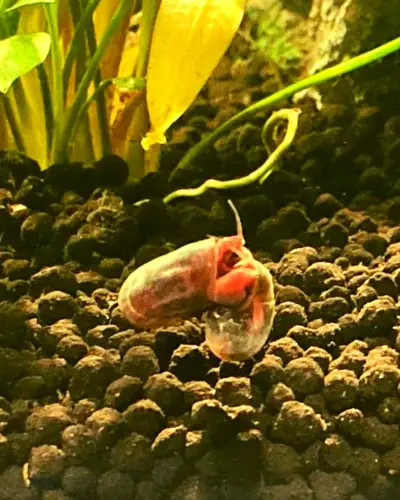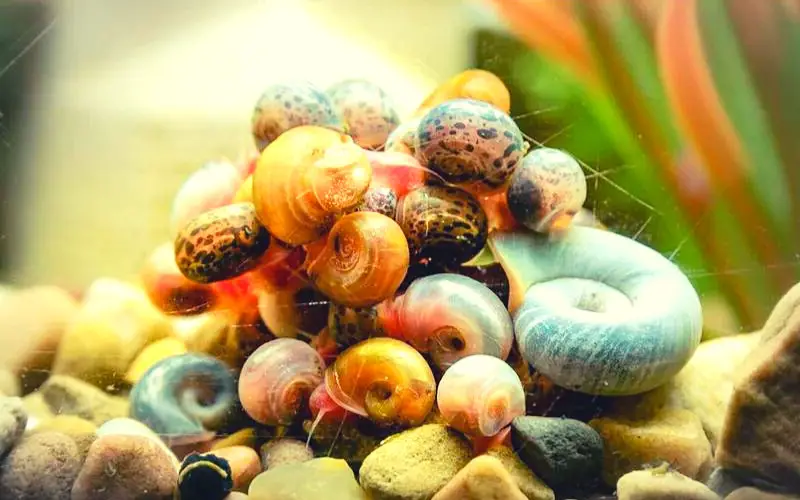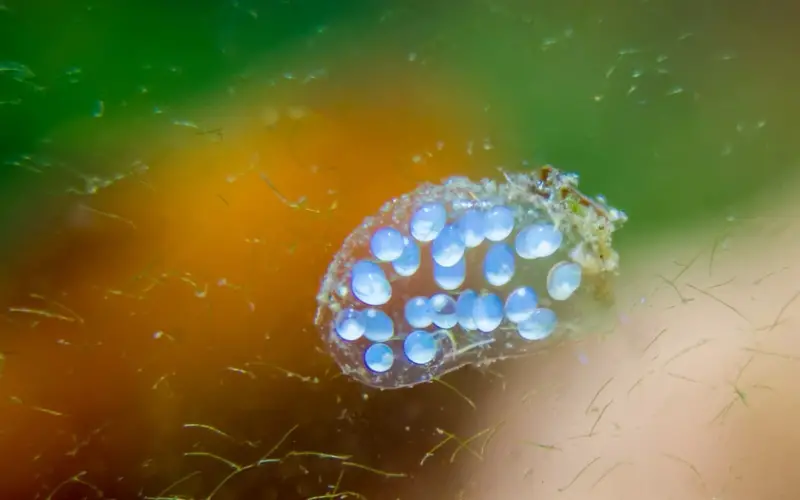Are you fascinated by the delicate beauty and unique behavior of aquatic snails? If you’ve ever wondered about ramshorn snail breeding, you’re not alone.
These charming snails, with their spiral shells and tireless energy, are not just a favorite among aquarists for their aesthetic appeal; they also play a vital role in maintaining a clean and balanced tank ecosystem.
But what if you could go beyond simply keeping them and dive into the rewarding experience of breeding them?
Breeding ramshorn snails is an exciting venture, offering insights into their fascinating life cycle and the opportunity to grow your aquatic community naturally.
Whether you’re looking to control algae, create a self-sustaining tank, or simply marvel at the wonders of snail reproduction, this guide will walk you through everything you need to know.

From setting up the perfect environment to nurturing the next generation of snails, we’ll uncover the secrets to success. Ready to explore the world of ramshorn snail breeding and take your aquarium hobby to the next level?
Let’s dive in and learn how to make these incredible creatures thrive in your care!
Table of Contents
ToggleBreeding Ramshorn Snails for Profit
Ramshorn snails are an aquatic snail species that can be bred in a freshwater aquarium for profit. These snails are hermaphrodites with both genders, male and female breeding organs.
This makes it easy for them to reproduce and lay eggs without a partner. Ramshorn snails prefer to lay their eggs in clusters on surfaces like algae wafers or aquarium algae. The eggs hatch into baby snails that will eventually grow into adults.
To keep your snail population healthy and growing, providing a diet rich in calcium, such as leftover fish food or specialized algae wafers, is essential.

Additionally, regular water changes and monitoring water parameters are crucial to ensure the snails live in conditions conducive to their growth.
One advantage of breeding ramshorn snails for profit is that they are resilient and can thrive in various water conditions. This makes them popular for aquarists looking to add a new and exciting element to their freshwater aquarium.
Unlike other snail species that can be sensitive to environmental changes, ramshorn snails are pretty hardy and can tolerate temperature and water quality fluctuations.
They also help keep a tank clean by feeding on decaying plant matter and uneaten food. In addition, their ability to reproduce asexually means that a single snail can quickly multiply and create a thriving snail tank.
Ramshorn Snail Breeding Rate
Ramshorn snails are prolific breeders, capable of reproducing at a rapid pace under optimal conditions. Their breeding rate depends on several factors such as food availability, water temperature, and tank conditions. Here’s an overview of their breeding rate:
- Egg Clutch Size
Ramshorn snails lay small clutches of eggs, typically containing 10–50 eggs. The eggs are encased in a gelatinous mass and are often found on aquarium surfaces like plants, glass, or decorations. - Hatching Time
The eggs usually hatch within 1–4 weeks, depending on the water temperature. Warmer water (around 75–80°F or 24–27°C) accelerates development, leading to quicker hatching. - Growth to Maturity
Baby snails grow rapidly and can reach breeding maturity within 4–6 weeks. Once mature, they can start laying eggs and contribute to the population growth. - Population Explosion
Under favorable conditions, ramshorn snails can reproduce exponentially, quickly resulting in a population explosion. Overfeeding the tank is a common cause of uncontrolled breeding, as excess food provides ample resources for growth and reproduction.
How to Control Breeding
To manage the breeding rate, consider:
- Reducing Food Waste: Avoid overfeeding your fish, as leftover food is a major food source for snails.
- Adding Predators: Fish like bettas, loaches, or certain cichlids may help control snail populations.
- Manual Removal: Regularly inspect the tank and remove egg clutches or excess snails by hand.
Understanding their breeding habits helps maintain a healthy balance in your aquarium ecosystem.
How Can I Identify Ramshorn Snail Eggs in My Aquarium?
Ramshorn snail eggs in your fish tank can be easily identified as small, translucent blobs attached to surfaces such as glass, aquatic plants, or decorations. These eggs are usually laid in clusters and can resemble a jelly-like mass.
Unlike mystery or assassin snails, ramshorn snails don’t need a mate to reproduce. They are hermaphrodites, meaning one snail can fertilize its eggs.

Ramshorn snails are prolific breeders, so if you see ramshorn snails in your tank, you can expect a population explosion if left unchecked.
Ramshorn snails are not harmful to most fish species, but aggressive fish like cichlids or freshwater puffer fish may prey on them. If you have a puffer fish or other snail-eating fish in your tank, you may only see ramshorn snails alive for a short time.
However, to keep the snails alive, consider moving them to a separate shrimp tank or providing ample hiding spots in your main tank.
What Conditions Do Ramshorn Snails Need to Breed?
Ramshorn snails are prolific breeders, and they don’t require a lot of special conditions to reproduce. However, there are a few things you can do to encourage them to breed:
- Provide a good food source: Ramshorn snails are herbivores, so they need a steady supply of algae, biofilm, or blanched vegetables. If enough is available, they may be more likely to breed.
- Maintain good water quality: Keep the water in your aquarium clean and free of ammonia and nitrates. These chemicals can be harmful to snails and can interfere with their reproduction.
- Keep the pH neutral to slightly alkaline: Ramshorn snails prefer water with a pH between 7.0 and 8.0. If the pH is too low or too high, it can make it difficult for them to reproduce.
- Provide a calcium source: Calcium is essential for building strong shells. Add calcium to your aquarium by adding crushed coral or cuttlebone to the filter.
- Introduce multiple snails: While ramshorn snails can self-fertilize, having multiple snails in the tank can increase the chances of successful reproduction.
If you follow these tips, you should see your ramshorn snail population start to grow! However, it’s important to note that ramshorn snails can reproduce very quickly, so you may need to take steps to control their population if they become too numerous.
Caring for Ramshorn Snails
Ramshorn snails are popular pets in freshwater tanks due to their unique appearance and ease of care. These snails are hermaphrodites, meaning they can reproduce independently, so if you start with just two snails, you may soon have many snails in your tank.
Ramshorn snails need a small tank with a seal their shells and a source of calcium, as the calcium helps them grow and reproduce. Keeping the tank at around 78 degrees Fahrenheit is ideal, and feeding them a proper amount of food is crucial.
These snails will eat live food like pond and bladder snails, but they also enjoy dead snails. Avoid overfeeding them, as this can lead to a pest snail infestation in your tank.
When purchasing ramshorn snails, check with your local fish store or pet stores, as they are commonly available. If you already have planorbarius corneus in your tank, be cautious, as these snails are often mistaken for ramshorn snails and can quickly reproduce.
Caring for ramshorn snails involves providing them with a proper substrate and a steady food supply and maintaining their tank at the right temperature to ensure their health and well-being.
Ramshorn Snails and Reproduction: Impact on Living Plants
Ramshorn snails, while generally considered beneficial aquarium inhabitants due to their algae-eating habits, can have a mixed impact on living plants depending on the specific circumstances:
Positive:
- Algae control: Ramshorn snails readily consume various algae types, including nuisance algae that can harm plants. This can promote healthier plant growth.
- Nutrient cycling: By eating detritus and decaying plant matter, ramshorn snails contribute to the breakdown of organic materials, releasing nutrients into the water column for plants to utilize.
- Substrate aeration: Their burrowing activity helps aerate the substrate, which can benefit root growth for some aquatic plants.
Negative:
- Plant nibbling: Although primarily algae eaters, ramshorn snails can also nibble on soft-leaved plants, especially young and tender ones. This can cause damage and hinder plant growth.
- Rapid reproduction: Ramshoorns are prolific breeders whose populations can quickly explode in favorable conditions. This can lead to competition for resources with plants, potentially impacting their health.
- Aesthetic concerns: Some aquarists may find many snails aesthetically displeasing, especially if their population becomes uncontrolled.
Factors to consider:
- Plant species: Some plants are more susceptible to snail damage than others. Choose hardy plants with more rigid leaves if you have ramshorn snails.
- Snail population: A small, controlled population of ramshorns is unlikely to cause significant harm to most plants. However, large, unchecked populations can become problematic.
- Feeding: Ensuring adequate food sources (algae, detritus) for the snails can help reduce their inclination to nibble on plants.
- Tank size: Larger tanks can better accommodate plants and a moderate snail population.
Overall:
While ramshorn snails can benefit planted aquariums, it’s essential to monitor their population and ensure they don’t become a nuisance to your plants. Maintaining a balanced ecosystem and choosing appropriate plant species can help you achieve a thriving tank with healthy plants and beneficial snails.
Additional tips:
- If you’re concerned about plant damage, consider introducing snail-eating fish or shrimp to control the ramshorn population.
- Manually removing some snails can also help manage their numbers.
- Adjust your feeding regime if you notice an increase in plant nibbling.
How Can I Manage the Population of Ramshorn Snails in My Aquarium?
Since ramshorn snails are hermaphrodites, they can reproduce quickly and in large numbers. If checked, this can lead to overpopulation in your aquarium. To manage the population of ramshorn snails in your aquarium, you need to consider a few factors.
One option is to introduce predatory fish that can help control the population of the snails. Some fish, like goldfish, enjoy preying on tiny snails. Another option is to limit the snails’ food supply by not overfeeding your fish.
Additionally, you can manually remove some snails from your tank to keep the population in check. It is recommended to have 2 to 3 ramshorn snails per 1 inch of fish in a gallon tank to prevent overcrowding.
The operculum of ramshorn snails isn’t only crucial for their protection and plays a role in reproduction. By taking these steps, you can effectively manage the population of ramshorn snails in your aquarium.
How Ramshorn Snails Relate With Tank Mates
Ramshorn snails are generally peaceful and make good tank mates for many fish. Here’s a breakdown of how they relate to different types of tank mates:
Good Tank Mates:
- Peaceful fish: Smaller fish like tetras, danios, rasboras, and guppies are excellent choices. They don’t see ramshorn snails as prey and won’t bother them.
- Bottom feeders: Corydoras catfish and Otocinclus catfish are great companions as they share similar peaceful temperaments and scavenging habits.
- Shrimp: Freshwater shrimp like cherry, ghost, and bamboo shrimp are compatible tank mates. They may compete for food but rarely harm the snails.
- Other snails: Nerite snails, mystery snails, and Malaysian trumpet snails are generally peaceful towards ramshorn snails, creating a diverse cleaning crew.
- Clams: Freshwater clams can coexist with ramshorn snails with enough food and space.
Bad Tank Mates:
- Aggressive fish: Cichlids, goldfish, pufferfish, and other aggressive fish will readily eat ramshorn snails.
- Loaches: Some loaches, like yo-yo loaches and clown loaches, may nibble on or harass ramshorn snails.
- Crayfish and lobsters: These crustaceans see snails as food and will quickly decimate a ramshorn population.
Things to Keep in Mind:
- Ramshorn snails can reproduce quickly, especially with ample food and good conditions. Be prepared to manage their population if necessary.
- Some fish, like bettas, may see ramshorn snails as exciting objects and occasionally chase them. While not usually harmful, it can stress the snails.
- Monitor your tank closely for signs of aggression or harassment towards the snails.
Overall, ramshorn snails are adaptable and peaceful creatures that can thrive in a community tank with suitable tank mates. Choose tank mates carefully and monitor the interactions to ensure a harmonious aquarium environment.
Frequently Asked Questions About Ramshorn Snails Breeding (FAQs)
How do you breed ramshorn snails?
Ramshorn snails readily breed in clean, well-fed tanks. Provide calcium & algae (or veggies) & they’ll lay eggs on surfaces. Hatchlings emerge in 10-20 days, needing similar care. But be warned, they multiply fast!
How fast do ramshorn snails grow?
Ramshorn snails reach adult size quickly, within 4-6 weeks, depending on food and temperature. Keep an eye on their population, as they’re prolific breeders!
How can you tell if a Ramshorn snail is male or female?
Unfortunately, it’s nearly impossible to tell! Ramshorn snails are hermaphrodites, meaning they have both male and female organs, making physical differentiation unreliable.
Are Ramshorn snails male or female?
Neither! Ramshorn snails are hermaphrodites, meaning they have both male and female reproductive organs – so they’re both in one!
How do you identify a Ramshorn snail?
Look for a flat, spiral shell like a ram’s horn, with only one pair of tentacles and a single opening on the right side. Colors vary from brown to red, blue, or even purple!
What can I do with too many ramshorn snails?
Sell, donate, or give away excess ramshorn snails to other aquarium enthusiasts, pet stores, or local fishkeeping communities to prevent overcrowding in your tank.
Can ramshorn snails live out of water?
No, ramshorn snails cannot breathe air or survive outside of water. They require a water environment in which to live and breathe properly.
How to stop ramshorn snails breeding?
To stop ramshorn snails from breeding, reduce overfeeding, manually remove eggs and snails, introduce snail-eating fish, or limit optimal breeding conditions like warm water and abundant food.
Conclusion
Breeding ramshorn snails can be a fascinating and rewarding experience for hobbyists and aquarists. These snails can make babies easily and frequently by providing the proper conditions and care. It is essential to consider the potential for rapid population growth and take precautions to prevent overpopulation in the aquarium. Additionally, maintaining a balanced ecosystem with ample food sources and clean water will ensure the health and longevity of the snails. By following these guidelines and monitoring the ramshorn snail mating process closely, enthusiasts can enjoy the sight of new ramshorn snail offspring and contribute to the diversity of their tank environment.
You might also like
- How to Get Rid of Ramshorn Snails in Aquarium (Solved)
- Ramshorn Snail Colors 101: Plant Friendly Tank Additions
- Are Ramshorn Snails Asexual: Unbelievable Solo Reproduction
- Ramshorn Snail Eggs 101: Everything You Need to Know!
- Ramshorn Snails: Tiny Tank Titans or Tidal Wave of Trouble?
- How Often Do Ramshorn Snails Lay Eggs in Aquarium: Explained
- Identifying Ramshorn Snail Babies in Your Tank (Proven Tips!)
- Ramshorn Snail Temperature Range 101: (A Detailed Care Guide)




